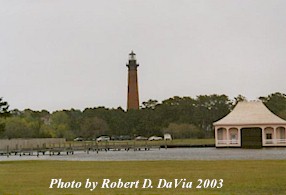
THE CURRITUCK BEACH LIGHTHOUSE

The following is taken from a handout provided at the Currituck Beach Lighthouse
CURRITUCK LIGHTHOUSE FACTS
Number of steps: 214
Height to focal plane of lens: 158 feet
Height to top of roof: 162 feet
Number of bricks: approximately one million
Thickness of wall at base: 5 feet – 8 inches
Thickness of wall at Parapet: 3 feet
Position:
34 miles south of the Cape Henry Lighthouse
32-1/2 miles north-northwest of the Bodie Island Lighthouse
36°22’36”
N Latitude
75°49’51”
W Longitude
As it had reported in previous years, the U.S. Lighthouse Board in 1872 stated that ships, cargoes and lives continued to be lost along the 40 miles of dark coastline that lay beyond the reaches of existing lighthouses. Southbound ships sailing closer to shore to avoid the Gulf Stream were especially in danger. In response, construction began on the Currituck Beach Lighthouse in 1873 with completion two years later.
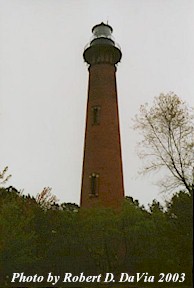
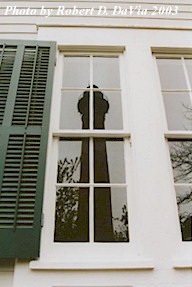
The Currituck Beach Lighthouse is known as a first order lighthouse, which means it has the largest of seven Fresnel lens sizes. The original source of light was a U.S. mineral oil lamp consisting of five concentric wicks; the largest was 4 inches in diameter.
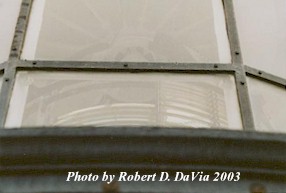
View of 1st Order Fresnel lens from gallery
Before the advent of electricity, a mechanical means was required to rotate the huge lens that made the light appear to flash. A system of weights suspended from a line powered a clockwork mechanism beneath the lantern – much like the workings of a grandfather clock. The keeper cranked the weights up by hand every two and a half hours.
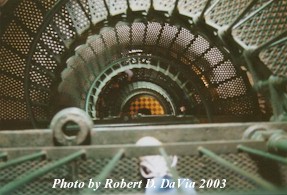
Looking down through the spiral stairway. This is
where the weights were that powered the clockwork
mechanism to rotate the lens.
Like the other lighthouses on North Carolina’s Outer Banks, this one still serves as an aid to navigation. The beacon comes on automatically every evening at dusk and ceases at dawn.
With a 20-second flash cycle (on for 3 seconds; off for 17 seconds), the light can be seen for 18 nautical miles. The distinctive sequence enables the lighthouse not only to warn mariners but also to help identify their locations.
The Currituck Beach Lighthouse was the last major brick lighthouse built on the Outer Banks.
CLIMB TO THE TOP
The Currituck Beach Lighthouse and Museum Shop are open daily from Easter through Thanksgiving. However, during periods of high winds or thunderstorms, the lighthouse may be closed to climbers. Winter months provide time for restoration and maintenance. Telephone (252) 453-4939 for lighthouse hours and information.
CURRITUCK BEACH LIGHTHOUSE
PO BOX 58
COROLLA, NC 27927
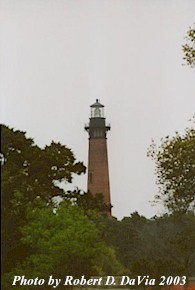
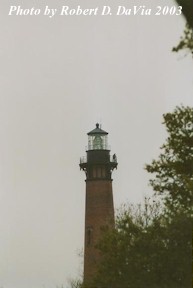
Views of the Currituck Beach Lighthouse, from the grounds of the Whalehead Club (the
yellow building in the picture below). In the picture on the right, notice the person on the right
side gallery
(walkway around the watchroom) to give you a sense of the size of the 1st order Fresnel
lens.
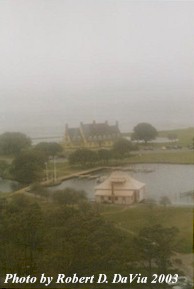
The Whalehead Club from atop the
Currituck Beach Lighthouse tower.
LIGHTHOUSE COMPOUND
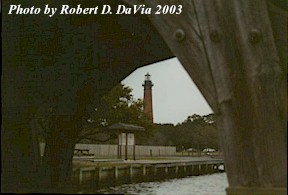

The Lighthouse Keepers’ House, a Victorian “stick style” dwelling, was constructed from pre-cut and labeled materials which were shipped by the U. S. Lighthouse Board on a barge and then assembled on site. In 1876, when the Keepers’ House was completed, two keepers and their families shared the duplex in the isolated seaside setting. The keepers were removed after the Lighthouse was automated and attendants were no longer needed to clean the lenses, trim the wicks, fuel the lamp, and wind the clockwork mechanism which rotated the beacon.
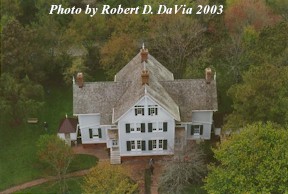
View of the duplex Keeper's house.
By the late 1970’s the Lighthouse Keepers’ House stood open to the elements with no windows or doors; porches had decayed and vines invaded the north side. Much of the interior millwork had been vandalized. Concerned about the preservation of the historic property, Outer Banks Conservationists, Inc., a private non-profit organization dedicated to the conservation of the character of the Outer Banks of North Carolina, signed a lease with the State of North Carolina in 1980 to begin a phased restoration of the property. The lease charged the group with the responsibility of restoring the Keepers’ House and improving the historic compound.
Today, the grounds and walkways are rejuvenated and the exterior of the Keepers’ House is nearly complete, but the phased restoration of the interior remains a considerable undertaking. Although plaster walls and pine floors have been repaired, vandalized wainscoting, replaced, and the mahogany balustrades replicated, reproduction doors and hardware must be made and installed, and interior finishes applied.
Identical in style to the large Keepers’ House, is a smaller Keepers’ House, an 1870’s dwelling moved from the Long Point Lighthouse Station on Currituck Sound to this site in 1920. The dwelling served as residence for the principal keeper and his family until 1939 when it was abandoned. It became so covered by vines and brush that for many years no one realized it was there. It was “rediscovered” during restoration of the Lighthouse Keepers’ House and now serves as a Museum Shop, offering models of lighthouses, books, pictures, shirts, and other lighthouse and wild horse-related items for sale to visitors.
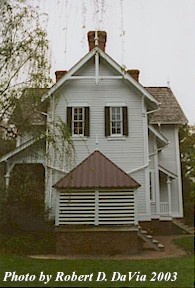
Side view of Keeper's House, with the cistern, for catching water, in front.
The lighthouse tower is to the right.
OBC has broad based support from donations and sponsorships. An annual sponsorship is $10 for an individual and $25 for a family. Each sponsorship includes a number of free visits and an annual newsletter. Donations are fully tax-deductible and sponsorships are deductible to the extent allowable by the IRS. Funds are used to further the restoration of the Keepers’ House and to maintain the historic compound. For additional information visit our website at www.currituckbeachlight.com, or contact the director/lighthouse keeper at 252-453-8152. email: info@currituckbeachlight.com.
Return to the North Carolina State Page
Return to the: Alphabetical Listing or the Listing by States